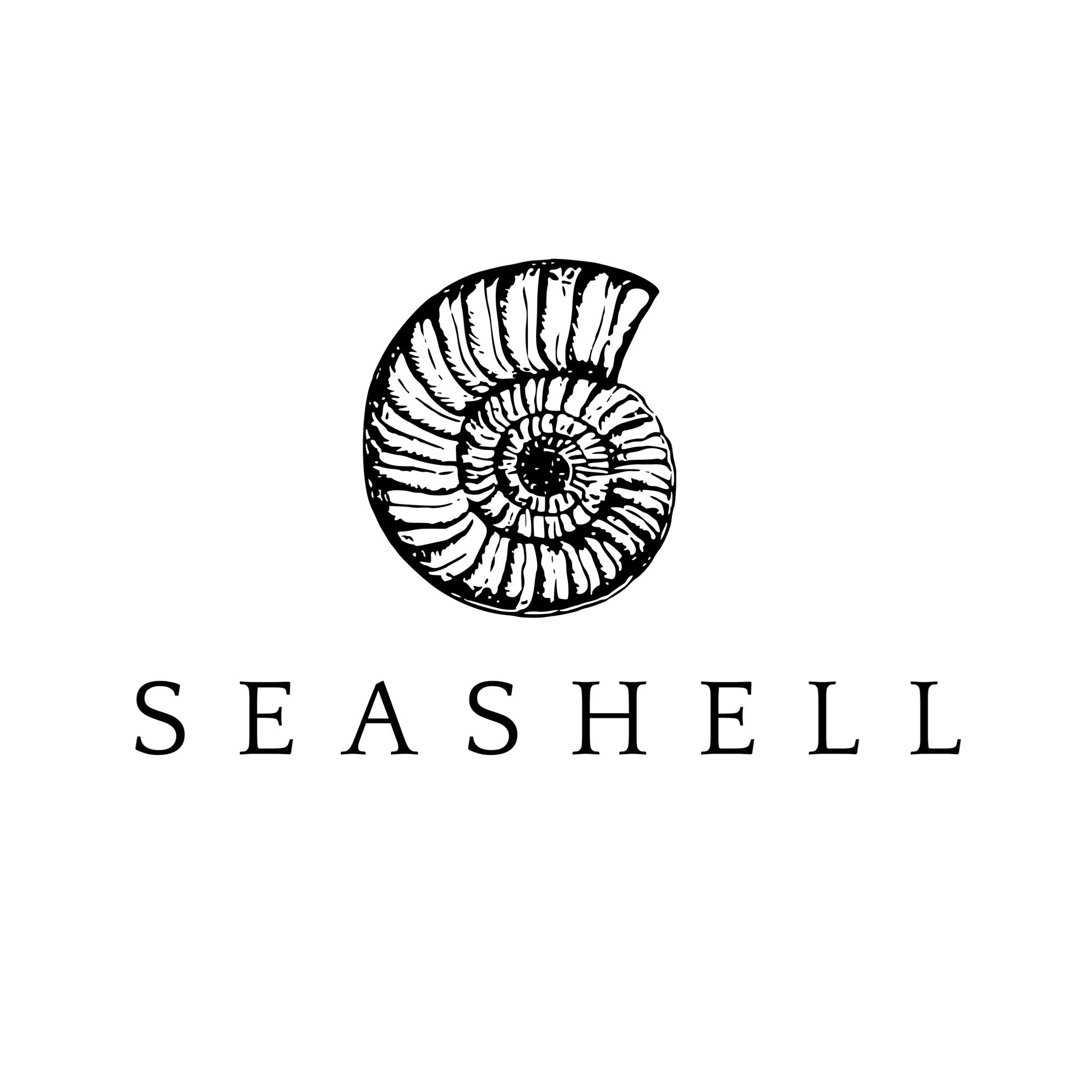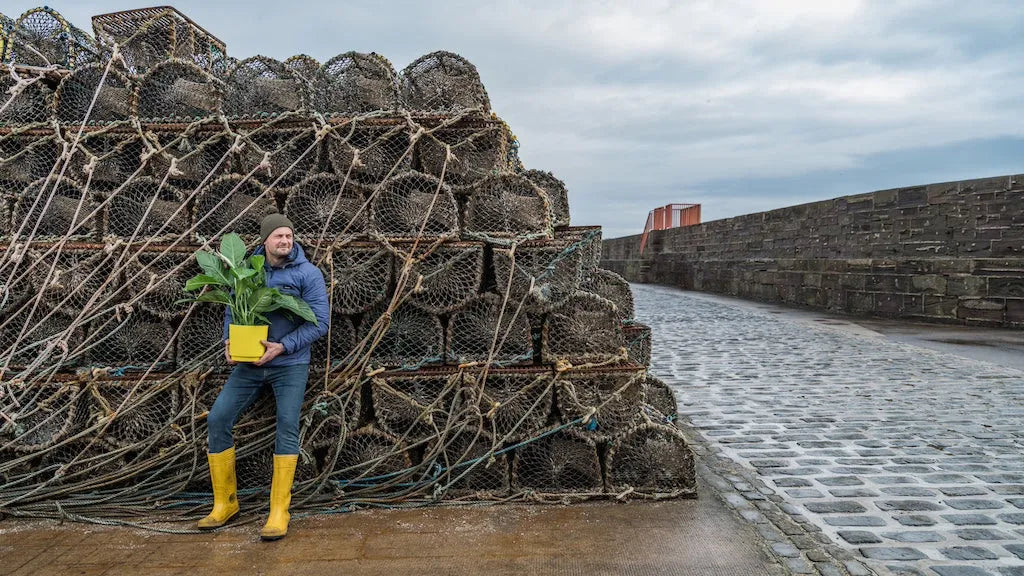Ocean Plastic Pots is a business dedicated to transforming discarded ocean plastics into sustainable, high-quality products, such as chef knives and award-winning plant pots. Born from a life-changing experience during the salvage of the MV Kaami, the company's founder turned an urgent problem into a creative solution, creating eco-friendly products from marine waste. This interview with founder Ally Mitchell and Fraser Stevenson explores the journey from a pivotal moment beneath the waves to a business built on purpose, craftsmanship, and a passion for protecting our planet.
Photo Credits to Grant Anderson & Marco Barcella.
The origins of Ocean Plastic Pots are deeply tied to your experience as a saturation diver on the salvage mission of the MV Kaami, a cargo ship carrying 1,937 tons of shredded waste plastic destined for incineration. How did this pivotal experience inspire you to create the business and shape its mission?
I suppose that salvage mission was one of the biggest catalysts for starting the company and leading us to where we are now. I always knew plastic waste was a real problem, but that mission really put in perspective how deep and urgent the issue is to society. I think, also, we’re almost led to believe that these big environmental issues are much further away from us so we don’t really need to worry, or we don’t need to worry anytime soon of the damage they could do to us. That salvage mission taught me that actually this issue is very much on our doorstep and needs addressed immediately.
When I reflect as well, I think it’s important that the mission and my initial inspiration to start the business happened during the Covid pandemic, maybe lockdown more specifically. It gave me time not only to research the basic engineering behind the pots and experiment with it, but also to develop my knowledge of the business side of things. Again, this was also totally new to me. Lockdown provided a really good almost pause on everyday life to let me do that.
Funnily enough recently I found out that that area [the Minch strait] where we salvaged the vessel is infamous in Scottish folklore for homing mythical creatures that bob in the water, much like waste plastic, waiting to drown and capsize captains and ships who disobey their orders. Perhaps the symbolism of the mission happening where it did may allude to a hint of fate in shaping the mission of the business. Or it’s just coincidental nonsense – you can decide!
To date you have recycled 25 tonnes of rope and fishing net from Scotland. How have you recovered it all?
It’s been quite an experience recovering the material. At the start of our journey, we were working with harbours, primarily in Inverness and Dunbar, to divert their waste fishing nets and ropes that had washed up. It takes a tonne of rope to make a consistent colour so it’s really good for us to have these relationships with harbours. We can be consistent with products we’re offering. Soon, we realised the colours were of advantage to the company’s story. Rope, we collect in Inverness is usually yellow whilst its blue in Dunbar so this really started the first idea of linking the colour of the pot to the location where the rope was collected. People love that. It really adds to the sales pitch when you can pin point a location connection between the customer and the plant pot they’re wanting to buy.
We also undertake a yearly project with a great initiative called Scottish Coastal Clean Up Initiative. They’re a group of volunteers that come together to clean coastlines all over. Scotland. This has been great for us. We’ve contributed to cleans on the West coast and Hebrides. The beach cleans are brilliant because it allows us to experiment with the colours we collect. Generally, the colours of rope we get from a beach clean are all mixed so the colour of pot we generate from that is different each year. I suppose this brings a uniqueness to the pots that customers really appreciate. Two years ago we had green pots from rope collected from the Isles of Canna, Coll, Muck, Rum and Eigg. At a show in North Berwick one American customer was so excited with this because that’s where her family had originated from.
Latterly we’ve been working with fish boxes to create our new knives and the swallows we make in collaboration with Anna Campbell-Jones. They’re a much tougher material than fishing rope so it’s been fascinating from a manufacturing perspective working how to mould them and make the process as efficient as possible, so the customer gets the best, most authentic product. I love challenging myself and this is something I can do on a daily basis with Ocean Plastic Pots.
Are there specific challenges in working with recycled ocean plastic compared to other recycled materials?
Like working with any material, recycled ocean waste comes with its own challenges, but I find harnessing these challenges a really enjoyable element of the job. That’s something that I didn’t expect would be key to our story.
The one critical challenge is the strength of the raw material. Fishing ropes are made of a polymer called polypropylene – this is the plastic that makes the ropes really strong but also hard to break down which is ultimately what causes the pollution. This means melting it down to get the plastic we use to create the pots can be quite a tricky and time-consuming process which has its downfalls. However, it also means you get an extremely strong pot that doesn’t absorb water, so it doesn’t crack in the wintertime. Funnily enough, we actually got an award from Which? Recommended for plant quality because of this feature!
Colour consistency can be another issue working with the recycled material but does create advantages. It takes a tonne of material to make a consistent colour, otherwise the pots tend to go a grey colour. A bit like when you mixed all the playdough together as a child, thinking you’d create some fantastic new colour and, invariably, it goes brown! Having said that, this issue means that no two pots have the same colour. Customers cherish this as it brings a uniqueness to their individual purchase.
I suppose the last potential challenge is, somewhat contrary to the last point, the scarcity of some material. Working with an abundance of ocean waste you’d think this would be no problem, but it can prove quite tricky. As I mentioned we team up with Scottish Coastal Clean-Up yearly to collect beach waste. This gives us rope of all different colours which means – on a yearly basis - it produces different colours of pots. This almost creates a scarcity of pots because we won’t be able collect the same mixture of colours again. Although, this creates an anticipation around our products which excites the customers which is really positive for our brand and message.
I think, in terms of challenges, that’s been one of the biggest surprises of the Ocean Plastic Pots journey. Despite them being there – they can be used as a real asset to the business which is invaluable in helping spread our message.
Is there a recovery mission or business milestone that stands out as particularly memorable or impactful?
I think the business milestone that stands out has to be winning the Sustainable Product of the Year at RHS Chelsea in 2021. It was our first time at the event, and it had been a hectic week so to get the award was they cherry on top. Everyone knows RHS Chelsea, so it was amazing for our profile, but also to be in company with some really impressive winners and some of the big names associated with the event.
At the time, we were only just over a year old, so it felt like all the tough, hard work had paid off. We had arrived in one sense. The win at Cheslea has also led and created opportunities which may or may not have happened or happened so quickly had we not picked up the award. That was a real advantage for not only the company but for me personally running the business.
I suppose it also gave us the confidence to be brave and experimental to achieve our message and business goals which, without doubt, has contributed to the whirlwind of a journey that we’ve been on for the past five years.
Can you tell us more about your collaboration with award winning interior designer Anna Campbell-Jones?
This is something that’s been really exciting to us as a business and been a really enjoyable project to take part in. Anna is really big on sustainability and a big name in the scottish design space, We met at SWG3 when we were both asked to speak to children at sustainability conference. We met for a coffee afterwards and we talked about items which would work well in the home environment. We came up with the idea of the swallow after I suggested flying ducks, and then Anna suggested swallows. She had a vintage swallow in her kitchen and the idea went from there.
During work on design and the feasibility we struck up a really good relationship. Anna has even joined us on some of our beach cleans. Since their launch, the swallows have flown off the shelf (pardon the pun!). Our First Stockist was the V&A In Dundee, Scotlands Design Museum.
It’s been a really rewarding experience but can be quite stressful (in the best way possible!). I think people have responded really well to the combination of our story, Anna’s profile and the swallows themselves. We recently did a show with Anna in Glasgow’s SECC. It was a big weekend and, again, extremely rewarding. People were really enthusiastic about the swallows but also keen to learn more about us as a business and our products.
What OPP product is your favourite to make and sell, and do you have plans to expand the range?
That’s a difficult one as I genuinely love all our products and the manufacturing process that goes into producing them! If I had to say one right now, it would probably be our brand-new range of kitchen knives. These really represented a sea change for our development as a business. We felt we had maybe hit a slight limit with the pots so this was a chance for us to further evolve the business so we can continue to innovatively spread our message of growing awareness of plastic pollution.
The idea to make the knives came from the manufacturing process of making our trowels which, funnily enough, was inspired by my mum! One day she had been complaining that her garden trowels were too flimsy, and she kept getting them lost in the compost. So, I thought: with the excess material used to create plant pots, could we make a colourful handle for a garden trowel? Amazingly we could! My mum was delighted (I love that the products have a family link), and they took off pretty well, in fact at a show in North Berwick in summer 2023 we totally sold out.
I used this knowledge to manufacture our kitchen knives, this time using fish boxes that been donated to us and the journey took off from there. We then went through a process of trial and error – seeing what worked and what didn’t. We manufacture the knives in-house so I suppose this made this process slightly easier as we could see in real time how the production was coming together.
I suppose I love making the knives because they clearly represent the stepping stones the company has taken. You know the trowels, our second product, came from taking excess materials from the plant pots – our first product. Then the knives – product three - come from the knowledge of creating the trowel handles. I love the organic nature of this process - each product is intrinsically linked. We trialled the knives at our shows during the Christmas period under the Ocean Kitchen Scotland brand last year and they were a real hit. I think at every show we did they, more or less, sold out which was just an excellent feeling.
We’re always looking to expand and evolve. Currently we’re working with a metal making company in Japan who hand-forge blades and, like us, all their products are 100% recycled. We want to make something that not only is sustainable but has a really compelling story behind it – it’s what has propelled the company to where we are now. It would also be good to have a recycled product where the materials have come from multiple countries. I think it’s a proper visual representation that we are committed to growing awareness of plastic pollution not just in Scotland or the UK but globally.
If you could achieve one major breakthrough in the fight against ocean plastic, what would it be, and how does your work contribute to that vision?
For me, it’s always important to be ambitious. I think one major breakthrough we aim to meet is breaking into and establishing ourselves in more practical, everyday markets. The pots have been fantastic in establishing our brand and the message we purport but generally people will buy them as a gift. Unfortunately, there’s a limit to how many gifts people can give to people! I think if we really want to push the message, we need to get into markets that resonate more closely with people’s everyday lives.
It’s important for us to break into or more markets where the products can be used in a more practical way. That’s been one of our primary aims with Ocean Kitchen Scotland and so far it’s going very well. In that regard, working with Anna has been great for pushing that – she brings a weight to the company that I could not do alone. That’s what we’ll keep trying to do and push throughout 2025 – fighting ocean plastic waste is what we’re built on and, by evolving, learning and reaching more people, it is what we’ll continue to do.
Find out more
From award-winning plant pots to new product lines like kitchen knives, each creation tells a story of sustainability and commitment. As the company continues to grow and inspire others, it remains anchored in its original purpose: turning ocean waste into opportunity and driving change, one recycled product at a time.


Come and join us!
Join us every Saturday at 10am at the Fittie end of Aberdeen beach for invigorating dips in the sea. The refreshing waters will not only revitalize your body but also uplift your spirits, offering a perfect blend of mental clarity and physical well-being.
For updates on volunteering at beach cleans, joining adventure days, and other upcoming events please see our social media pages.
The ultimate guide to unlocking the full potential of one of nature's most powerful resources.
Cold water has been used for centuries as a natural remedy to promote health, vitality, and well-being, and its benefits are backed by science.
Whether you're a seasoned cold water enthusiast or just starting out, this comprehensive guide will provide you with all the information you need to harness the power of cold water and take your health and wellness to the next level.












Where Giants Roam: Discovering Scotland’s Basking Sharks
Shark Myths, Net Hunting, and Seashell Art: February Recap